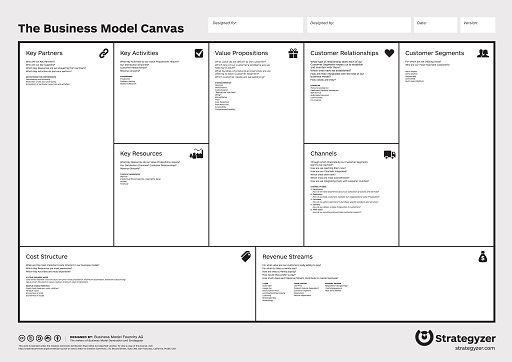Use 'Print preview' to check the number of pages and printer settings.
Print functionality varies between browsers.
Printable page generated Tuesday, 23 April 2024, 9:03 AM
Developing your business model
Introduction

Renowned management guru, Peter Drucker, once asserted that there are five key questions you must ask yourself about your business:
What is our mission?
Who is our customer?
What does the customer value?
What are our results?
What is our plan?
Each of these are critical questions and together they should form the basis of the way in which you approach doing business – your business model.
In this unit you will consider how you might develop an effective business model and make money from your product, service or big idea.
1 What is a business model?
At its core the concept of a business model is actually fairly simple. As one thinker put it:
A business model is essentially a description of ‘how you planned to make money’ from the business.
The problem for many early-stage entrepreneurs is that with all the excitement of launching a new business and the challenge of finding customers and making things work, the nuts and bolts of making money (most especially a profit!) might slip from the agenda. Yet, as the Danish academics Christian Nielsen and Morten Lund have pointed out:
No management activity is more important than having clarity about how the organization creates, delivers, and captures value. It requires, among other things, knowing what customers want, how value can be best delivered, and how to enlist strategic partners to achieve maximum benefit.
2 The Business Model Canvas
One of the most accessible and straightforward approaches to developing, analysing and understanding a business model is the Business Model Canvas (Figure 2).
(Note: If you are viewing the Business Model Canvas PDF on screen then zooming is required for readability. If you are printing this PDF then A3 size or larger is recommended.)
The Business Model Canvas approach was developed by Alexander Osterwalder (2012) and can be applied to organisations of any size, type or sector. It describes an organisation and its functioning in terms of nine specific areas:
Customer segments – the customer and market segments you serve.
Value propositions – how you solve customer problems and satisfy their needs.
Channels – how you deliver your unique value proposition to customers, including communication, distribution and sales channels, among others.
Customer relationships – how you maintain relationships with customers and customer segments and the types of relationship you have.
Revenue streams – income and revenue from the sale of your product, service or idea.
Key resources – the most important resources required to deliver your unique proposition to the market.
Key activities – what you actually do as a business in order to generate revenue streams and deliver your offer to the market.
Key partners – who you partner with outside the business in order to deliver your proposition, e.g. suppliers, distributors, etc.
Cost structure – the costs you incur and the way your costs are structured and managed.
(For more detail see Osterwalder and Pigneur, 2010.)
Activity 1 The role of the Business Model Canvas
In this 3-minute video clip (Stanford eCorner, 2012), Alexander Osterwalder, creator of the Business Model Canvas, explains how it all fits together:
As you are watching, reflect on your business or a business you are familiar with. Can you see how each of the nine areas of the Business Model Canvas has a role to play in supporting business success?
Discussion
An important issue to consider is that the information inserted in the categories of the canvas are coherent. This is a critical issue that affects the credibility of your business model and the feasibility of your entrepreneurial idea.
For example, if the channel chosen to target your key customers is not appropriate, your business model will be questioned. Using internet sales to target people who don’t use the internet means that your idea does not address your customers’ actual needs. In addition, costs and revenues that are not balanced mean that your business will not be financially sustainable, hence putting your venture at risk.
3 Where do business models come from?

While in some situations a business model might emerge on the basis that it is the ‘right thing to do’ or it just makes sense, at other times – such as when considering specific opportunities or challenges – you will need to plan and make conscious decisions about your business and how it will grow and develop.
A simple example might serve to illustrate this.
Imagine you have started a business selling homemade jams at local farmers’ markets. After several months of doing this successfully you might recognise that the ‘natural thing to do’ would be to augment your offering with a range of fresh breads that customers could buy with their jam. Adding bread would be an extension of the product range and would complement and provide added value for your customers.
Importantly, this diversification of your offering would, among other things:
bring additional revenue streams
broaden the range of customers
change the supplier base
impact the business costs.
Now fast-forward 12 months: your business has been so successful that you have been approached by a major national retail chain that wishes to stock your product. A decision to accept this offer would mean a complete change in virtually each of the nine areas of the Business Model Canvas: new partnerships will be required, different resources will be critical, your revenue and cost structures may well be radically different.
What might seem like the big opportunity you have been waiting for could force you to radically change your business model in new and unexpected ways. This can lead you to consider the unique value proposition that you are offering to the market, and most particularly how you are creating value for existing and potential customers.
It is consequently important to recognise that while the ‘natural thing to do’ can serve you well up to a point, it is critical for the growth and long-term success of a business that the business model is consciously reviewed and updated on a regular and structured basis. This is to ensure that the business model remains fit for purpose and that strategic decisions made earlier in the business’s life cycle are not now impeding its future growth.
This review might involve some simple tweaking, or perhaps full-scale business model innovation (Jarrell, 2017).
4 What is your unique value proposition?

One of the earliest questions you should be asking yourself as an entrepreneur is: ‘Why should customers care about my product or service?’. In business parlance, your unique value proposition is what sets you apart from your rivals. It’s the secret sauce that makes your product something people should pay attention to, and want to purchase from you.
Before you can consider trying to sell your product or service to anyone else, you need to sell it to yourself. This consists of mapping out why your product matters, and effectively pinpointing what makes you unique. If you can’t achieve this, you can’t hope to market yourself effectively.
It is critical for the success of any business that you have a clear picture of what makes you unique and, in particular, what makes your proposition unique and uniquely valuable for your existing and potential customers. Perhaps it is modesty or perhaps it is a lack of clear thinking, but distilling your unique value proposition and understanding what distinguishes you in a crowded marketplace can be one of the hardest things you will do in business.
So how can you define your unique value proposition?
A good way to approach it can be by asking yourself some key questions:
What customer problem are we attempting to solve?
What customer needs do we try to satisfy?
What segment-specific products and services do we offer our customers?
What value do we generate for our customers?
How does our value proposition differ from that of the competition?
Having a clear answer to these questions will help you define your unique value proposition for the long term.
Activity 2 Your unique value proposition
Discussion
There are no correct answers to these questions. The responses you give will very much depend on your business, the stage of development of your business idea and the field in which you are operating. Someone at the early stages of setting up a retail concept will, for example, have very different answers from someone managing an investor-ready tech start-up.
You should nonetheless take the time to consider these questions on a regular basis. If you are unable to answer them, or find it difficult to answer them clearly, it might be worth taking a step back and ensuring that you are on the right path.
5 What are your unique capabilities?
A business’s capability is essentially its ability to ‘deploy resources effectively’ (Menguc et al., 2014, p. 315) in order to achieve its desired goal. If we consider the wide range of resources available to a business, from the people to the financial and everything in between, it is clear that a business’s capabilities should be understood broadly to include any of the following:
Skills and knowledge
Machinery and technology
Managerial systems
Values and norms
Organisational processes
Learning.
But why is this important? In essence, it is the unique utilisation and application of these capabilities that ‘may be at the root of why two firms that have similar resources obtain drastically different levels of performance’ (Menguc et al., 2014, p. 315).
Equally, as you reviewed this list you might have noticed that while some of the capabilities listed are quite tangible – machinery and technology, for example – others such as skills, knowledge and learning are quite intangible. Very often intangible capabilities are just as important as tangible capabilities, most particularly in knowledge-based businesses.
For you as an entrepreneur, the secret is to recognise your own capabilities and to understand how they are unique. It is these capabilities that will support your business model and enhance your unique value proposition.
Activity 3 Your unique capabilities
What are your unique capabilities? Take a moment to reflect on what capabilities you have that are truly unique and how these might support your business model. You might wish to consult with a mentor or colleague who knows you and your business well.
Discussion
At this stage you might struggle to identify capabilities that are unique to you and your business. That is ok!
Over time you should continue to reflect on this and look to strengthen and fine tune your capabilities to ensure that you are building upon your strengths and taking steps to address any weaknesses.
6 Innovating your business model
Sometimes, however, you might need to be more proactive in how you adapt your business model. There might be many reasons for this, including the desire to prepare for new opportunities or perhaps to refine the way you are doing things in order to reach even greater heights of success.
In such situations it is necessary to take a more considered and conscious approach to innovating your business model. This might mean deliberately and carefully addressing some, if not all, of the nine key elements of the Business Model Canvas.
So how can you do this?
Girotra and Netessine assert that innovating your business model involves re-evaluating four key elements:
What your offerings will be, when decisions are made, who makes them, and why. Successful changes along these dimensions improve the company’s combination of revenue, costs, and risks.
While this might seem like a straightforward exercise, it is worthwhile undertaking it on a regular basis. This can be done through individual reflection, though involving other people and drawing on their expertise and perspectives can be particularly beneficial.
If change is necessary, a ‘pivot’ might be in order. To learn more about pivoting take a look at the Pivoting unit of the Entrepreneurship Accelerator programme.
7 What is your ‘go to market’ strategy?
Your ‘go to market’ strategy will very much depend on the product or service you are offering. There is no single right way to approach the market and it might be a case of trial and error until you find the model that really works for you.
How will you generate revenue?

For many start-ups the natural tendency can be to make and provide your own product or service. Yet there are a number of other approaches worth considering that can help you generate revenue:
Acting as a third-party distributor servicing a particular market or territory (e.g. taking on a franchise or licence for an existing business).
Buying and reselling someone else’s product (e.g. importing).
Buying and transforming someone else’s product or service to provide something new to the market (e.g. assembling a product or service consisting of different parts and reselling it as your own).
It is also worth considering how you might gain valuable business insight through partnering and leveraging the best that various parties have to offer.
Pricing strategies
Some basic approaches to pricing include:
Free samples – offering potential customers free samples of your product or service in order to generate interest and sales (e.g. tasting samples offered by cafes or supermarkets).
Licensing – while you maintain ownership of your intellectual property, you license other people to re-sell your product or service in a given market and/or for a given period (e.g. a franchise such as Subway).
Freemium – a version of your product or service with limited functionality is made available to customers for free, and they have the option of upgrading to a paid service with full or additional functionality (e.g. LinkedIn).
Subscription – customers pay you a regular subscription fee in return for the right to use or receive your product or service (e.g. Sky TV).
Loss leader – selling a particular product or service at or near a loss in order to entice further sales of other products (e.g. printers are often sold relatively cheaply in order to lock consumers into buying printer cartridges).
These are only examples and the ways in which you can sell your product or service is virtually endless. However you do it, just remember that each approach comes with certain risks that need to be carefully managed.
Activity 4 Your pricing strategy
What is your pricing strategy? Review the list of examples given to see if one of these is appropriate for you or if another approach is needed.
Discussion
The approach you take to pricing your offering will have significant implications for your long-term revenue and profitability levels. This is particularly so if your business model requires you to sign long-term contracts with clients, which can result in you being locked into less than ideal pricing structures.
While you can, of course, change the approach over time, this can actually be quite difficult to achieve, most especially if your customers are reluctant to do things differently or if contracts are in place.
Summary
While there is no single perfect business model, there are nonetheless some basic things you must consider. In this unit we have introduced you to the Business Model Canvas and outlined key elements required for the effective growth of your business model. While you cannot work on them all at once, a methodical approach will help you ensure that no inadvertent mistakes are made as you grow and develop your business.
References
Acknowledgements
Every effort has been made to contact copyright holders. If any have been inadvertently overlooked the publishers will be pleased to make the necessary arrangements at the first opportunity.
Important: *** against any of the acknowledgements below means that the wording has been dictated by the rights holder/publisher, and cannot be changed.
Grateful acknowledgement is made to the following sources:
Figure 1: Isaac Mao. This file is licensed under the Creative Commons Attribution Licence http://creativecommons.org/ licenses/ by/ 2.0/
Figure 2: ***© Business Model Alchemist, This file is licensed under the Creative Commons Attribution-Share Alike Licence http://creativecommons.org/ licenses/ by-sa/ 3.0/
Figure 3: Image by Michal Jarmoluk from Pixabay
Figure 4: Image by mightybutton from Pixabay
Figure 5: © melpomen / 123 Royalty Free
